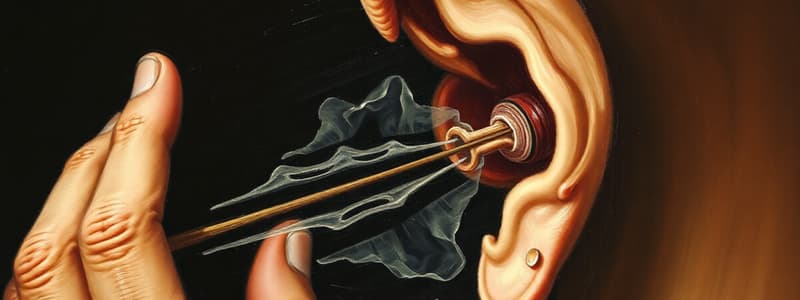Podcast
Questions and Answers
What is the primary function of the helicotrema in the cochlea?
What is the primary function of the helicotrema in the cochlea?
Which of the following statements about the basilar membrane is true?
Which of the following statements about the basilar membrane is true?
Which structure is primarily involved in static equilibrium?
Which structure is primarily involved in static equilibrium?
What causes the bending of hair cells in the utricle and saccule?
What causes the bending of hair cells in the utricle and saccule?
Signup and view all the answers
Which statement correctly describes dynamic equilibrium?
Which statement correctly describes dynamic equilibrium?
Signup and view all the answers
What is the role of the ampulla within the semicircular canals?
What is the role of the ampulla within the semicircular canals?
Signup and view all the answers
How does the brain interpret the signals from the semicircular canals?
How does the brain interpret the signals from the semicircular canals?
Signup and view all the answers
What type of sound waves are detected near the base of the cochlea?
What type of sound waves are detected near the base of the cochlea?
Signup and view all the answers
Which of the following correlates height of sound waves with its intensity?
Which of the following correlates height of sound waves with its intensity?
Signup and view all the answers
What is the main sensory organ for hearing located in the cochlea?
What is the main sensory organ for hearing located in the cochlea?
Signup and view all the answers
What role does the tympanic membrane play in hearing?
What role does the tympanic membrane play in hearing?
Signup and view all the answers
How do the ossicles amplify sound vibrations?
How do the ossicles amplify sound vibrations?
Signup and view all the answers
What is the primary function of the Organ of Corti?
What is the primary function of the Organ of Corti?
Signup and view all the answers
Which structure in the cochlea is responsible for distinguishing high-frequency sounds?
Which structure in the cochlea is responsible for distinguishing high-frequency sounds?
Signup and view all the answers
What is tonotopic organization in the cochlea?
What is tonotopic organization in the cochlea?
Signup and view all the answers
How do hair cells in the Organ of Corti detect sound vibrations?
How do hair cells in the Organ of Corti detect sound vibrations?
Signup and view all the answers
What function does the oval window serve in the hearing process?
What function does the oval window serve in the hearing process?
Signup and view all the answers
Where in the cochlea are low-frequency sounds primarily detected?
Where in the cochlea are low-frequency sounds primarily detected?
Signup and view all the answers
Why is the shape of the external ear important for hearing?
Why is the shape of the external ear important for hearing?
Signup and view all the answers
What triggers the generation of action potentials in hair cells?
What triggers the generation of action potentials in hair cells?
Signup and view all the answers
Study Notes
Hearing Process
- Sound waves enter the external ear (pinna), funneling towards the external auditory canal.
- Sound waves vibrate the tympanic membrane (eardrum).
- The vibrations pass to the ossicles (malleus, incus, stapes), amplifying the vibrations.
- The stapes vibrates the oval window, transmitting vibrations to the cochlea.
- Cochlear fluid transmits pressure waves through the cochlea, vibrating the basilar membrane.
- Hair cells on the basilar membrane bend, triggering electrical signals.
- Electrical signals travel to the brain through the auditory nerve.
Cochlea Structure and Function
- Cochlea is a spiral-shaped structure containing the sensory organ for hearing (Organ of Corti).
- Tonotopic organization: Different frequencies stimulate different areas of the basilar membrane.
- High-frequency sounds vibrate near the base of the cochlea.
- Low-frequency sounds vibrate near the apex of the cochlea (Helicotrema).
- The basilar membrane varies in stiffness; stiffer near the base and more flexible near the apex.
Inner Ear: Balance and Equilibrium
- Inner ear also has a vital role in balance called Equilibrium.
- Two types of equilibrium exist: Static and Dynamic.
Static Equilibrium
- Related to posture and orientation during stationary or slow movements.
- The vestibule (utricle and saccule) contains hair cells embedded in a gelatinous substance.
- Calcium carbonate crystals (otoconia) shift due to head movement, bending hair cells.
- This movement generates nerve impulses, letting the brain know the head's position.
Dynamic Equilibrium
- Detects rapid head movements, mainly rotational acceleration.
- Semicircular canals (anterior, posterior, lateral) are involved.
- Endolymph fluid movement within the semicircular canals bends hair cells in the ampulla, a structure within each canal.
- This generates nerve impulses that aid brain's interpretation of rotational head movements.
Studying That Suits You
Use AI to generate personalized quizzes and flashcards to suit your learning preferences.
Description
Explore the intricate processes involved in hearing, from the entry of sound waves to the brain's perception of sound. This quiz will cover the structure and function of the cochlea, including its role in the detection of different sound frequencies.




